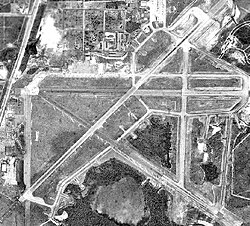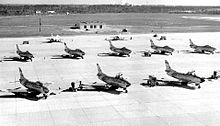Imeson Field: Difference between revisions
→World War II: edited and expanded |
→World War II: edited and expanded |
||
| Line 44: | Line 44: | ||
===World War II=== |
===World War II=== |
||
As part of the buildup of forces prior to the United States entry into [[World War II]], the [[Army Air Corps]] leased Imeson Field from the City of Jacksonville on 6 February 1941. Construction of military facilities at '''Jacksonville Army Airfield''' began on 5 April. It was assigned to I Bomber Command, First Air Force. A flight of the [[16th Observation Squadron]] (Medium) was assigned with light observation aircraft with a mission of monitoring coastal airspace for Nazi [[U-Boats]]. Jurisdiction was transferred to [[Army Air Forces Antisubmarine Command]] which assigned the [[7th Antisubmarine Squadron]] in December 1942. Antisubmarine aircraft operated with [[A-20 Havoc]] light bombers and [[B-18 Bolo]] medium bombers equipped with submarine detection equipment. |
As part of the buildup of forces prior to the United States entry into [[World War II]], the [[Army Air Corps]] leased Imeson Field from the City of Jacksonville on 6 February 1941. Construction of military facilities at '''Jacksonville Army Airfield''' began on 5 April. It was assigned to [[I Bomber Command]], [[First Air Force]]. A flight of the [[16th Observation Squadron]] (Medium) was assigned with light observation aircraft with a mission of monitoring coastal airspace for Nazi [[U-Boats]]. Jurisdiction was transferred to [[Army Air Forces Antisubmarine Command]] which assigned the [[7th Antisubmarine Squadron]] in December 1942. Antisubmarine aircraft operated with [[A-20 Havoc]] light bombers and [[B-18 Bolo]] medium bombers equipped with submarine detection equipment. |
||
The antisubmarine mission was turned over to the United States Navy in mid-1943, and [[Naval Auxiliary Air Station Jacksonville]] began to operate [[Consolidated PB4Y-1]] (B-24D Liberator) long range bombers from Jacksonville AAF equipped with antisubmarine equipment. The improved PB4Y-2 long-range maritime patrol aircraft, designed by Consolidated specifically for Navy use began to arrive during the late summer of 1944. The base's maximum complement of 67 aircraft was reached in 1945. |
The antisubmarine mission was turned over to the United States Navy in mid-1943, and [[Naval Auxiliary Air Station Jacksonville]] began to operate [[Consolidated PB4Y-1]] (B-24D Liberator) long range bombers from Jacksonville AAF equipped with antisubmarine equipment. The improved PB4Y-2 long-range maritime patrol aircraft, designed by Consolidated specifically for Navy use began to arrive during the late summer of 1944. The base's maximum complement of 67 aircraft was reached in 1945. |
||
On 31 August 1943 USAAF Antisubmarine Command returned to the control of First Air Force and Jacksonville AAF was transferred to Third Air Force jurisdiction, and became a sub-base of [[MacDill Army Airfield]]. It was subsequently transferred to control of [[Chatam Army Airfield]], Georgia. |
|||
===Postwar use=== |
===Postwar use=== |
||
Revision as of 13:38, 24 July 2012
Imeson Field Jacksonville Army Airfield | |
|---|---|
 1966 USDA aerial photo | |
| Summary | |
| Location | Jacksonville, Florida |
| Elevation AMSL | 20 ft / 6.1 m |
| Coordinates | 30°25′12″N 081°38′24″W / 30.42000°N 81.64000°W |
| Map | |
Imeson Field, also known as Jacksonville Imeson Airport, was the airport serving Jacksonville, Florida, from 1927 until its closing in 1967. It was known as Jacksonville Municipal Airport prior to World War II, Jacksonville Army Airfield when the United States Army Air Forces controlled the facility during World War II, and at its closing the airport was Jacksonville - Thomas Cole Imeson Municipal Airport.
History
Origins
Imeson Field was built southeast of the intersection of North Main Street (U.S. 17) and Busch Drive, the site of a 175-acre (71 ha) prison farm north of downtown Jacksonville. Originally it had a 2,100-foot cinder and shell runway, a 2,500-foot grass runway, an administration building and a hangar. By 1934 the Department of Commerce Airport Directory said Jacksonville Airport had four "sandy, sodded, surfaced" runways, all 2,500 feet long, with a row of hangars on the side of the airfield. The manager was listed as Major Herbert A. Maloney.
Jacksonville Municipal Airport Number One opened on October 11, 1927. A dedication ceremony prior to the opening included Charles Lindbergh, who flew to Jacksonville in the "Spirit of St. Louis" to promote the new airport still under construction and to help promote Jacksonville's aviation industry. Aviation was still considered a novelty, but he assured city leaders that air passenger service would span the nation. Eastern Air Service (later known as Eastern Air Lines) was the first carrier to provide passenger service to Jacksonville beginning in 1931.
By 1941 the airport had expanded to 600 acres (240 ha) adding five hangars, a terminal building and five asphalt runways, the longest being 7,000 feet (2,100 m). Airline service was provided by Atlanta-based Delta Air Lines (1924–present), Miami-based Eastern Airlines (1926–1991), United Airlines, National Airlines (1934–1980, which at one time made Jacksonville its headquarters), Boston-based Northeast Airlines and Atlanta-based Southern Airways (1949–1979).
Originally named Jacksonville Municipal Airport Number One, in the 1950s the facility was renamed after Thomas Cole Imeson (1880–1948), city councilman and later longtime commissioner in charge of airports and highways. Imeson’s work led to the creation of Jacksonville Municipal Airport, as well as improvements to its runways, hangars and terminal buildings. This facility was the city's main airport for 42 years. Thomas Imeson died at the age of 68 in March 1948.
In an era of multistop airline flights JAX was busier than people nowadays would expect. The April 1957 Official Airline Guide shows 75 weekday departures: 41 Eastern, 22 National, 9 Delta and 3 Southern.[1]
The largest airliner scheduled into Imeson was the McDonnell Douglas DC-8-61 flown by Delta Air Lines. Other jet service was provided by Delta Air Lines, Eastern Airlines, National Airlines, Northeast Airlines and United Airlines operating Boeing 707s, 720s, 727s, Convair 880s and McDonnell Douglas DC-8s and DC-9s. Eastern Airlines and National Airlines also provided turboprop service with the Lockheed L-188 Electra.
Flight kitchen and catering services were provided to the airlines by Dobbs House Inc. founded by James K. Dobbs, Sr., based out of Memphis, Tennessee. Dodds House eventually sold the company to Beech-Nut Life Savers in 1966 but the company continued to operate under the Dobbs House Inc. name.
World War II
As part of the buildup of forces prior to the United States entry into World War II, the Army Air Corps leased Imeson Field from the City of Jacksonville on 6 February 1941. Construction of military facilities at Jacksonville Army Airfield began on 5 April. It was assigned to I Bomber Command, First Air Force. A flight of the 16th Observation Squadron (Medium) was assigned with light observation aircraft with a mission of monitoring coastal airspace for Nazi U-Boats. Jurisdiction was transferred to Army Air Forces Antisubmarine Command which assigned the 7th Antisubmarine Squadron in December 1942. Antisubmarine aircraft operated with A-20 Havoc light bombers and B-18 Bolo medium bombers equipped with submarine detection equipment.
The antisubmarine mission was turned over to the United States Navy in mid-1943, and Naval Auxiliary Air Station Jacksonville began to operate Consolidated PB4Y-1 (B-24D Liberator) long range bombers from Jacksonville AAF equipped with antisubmarine equipment. The improved PB4Y-2 long-range maritime patrol aircraft, designed by Consolidated specifically for Navy use began to arrive during the late summer of 1944. The base's maximum complement of 67 aircraft was reached in 1945.
On 31 August 1943 USAAF Antisubmarine Command returned to the control of First Air Force and Jacksonville AAF was transferred to Third Air Force jurisdiction, and became a sub-base of MacDill Army Airfield. It was subsequently transferred to control of Chatam Army Airfield, Georgia.
Postwar use

After the end of World War II the Navy returned the field to the city, which reopened it as a civil airport named Jacksonville Imeson Airport. The airport was named after Thomas Cole Imeson, a longtime city councilman whose visionary work led to the opening of the airport in the 1920s. Thomas Imeson died in 1948.
With the establishment of an independent U.S. Air Force in 1947 the U.S. Army Air Forces aviation organization of the Florida National Guard became the Florida Air National Guard. The Jacksonville Air National Guard Station was established at Imeson, eventually supporting the 125th Fighter Interceptor Group (125 FIG), gained by the Air Defense Command (ADC). During this time the Air National Guard operated a variety of aircraft, including the F-51 Mustang, F-80 Shooting Star, F-86 Sabre and F-102 Delta Dagger.
Imeson flourished during the 1950s. With the introduction of jet airliners in the early 1960s, however, the geographic limitations which precluded lengthening the runways became a fatal liability.
The new Jacksonville International Airport was opened five miles to the north in 1967, and civilian and Air National Guard operations at Imeson Airport ended in 1968 as they relocated to the new airport.
Florida Air National Guard

Jacksonville Army Airfield was transferred to the jurisdiction of Fourteenth Air Force on 15 December 1946. It became a reserve Air National Guard base under Air Defense Command. The Florida Air National Guard 159th Fighter Squadron began operations at Imerson Field on 9 February 1947 with an initial strength of 18 personnel and was equipped with the P-51 Mustang.
The unit was called to active duty on 10 October 1950 as a result of the outbreak of the Korean War. The unit was released from active duty on 9 July 1952. On 1 July 1956, the primary unit designation was changed to the 125th Fighter Interceptor Group. In 1971, following completion of the new Jacksonville International Airport, the 125 FIG relocated from Jacksonville Imeson Airport to a newly constructed military installation at the new airport. With the concurrent closure of Imeson Airport and its conversion to an industrial park, the 125 FIG vacated its former facilities and turned over same to the City of Jacksonville.
Imeson Industrial Park
In 1970 Webb International Inc. purchased the former 1,500-acre (6.1 km2) airport and turned it into a new commerce center, Imeson International Industrial Park, with numerous buildings being constructed over the former runways.
The southeastern portion of Runway 30 has been reused as Imeson Park Boulevard.
Historic notes
Local pilot Laurie Yonge offered airplane rides from the beaches. Rates were $5 for short hops, $10 for long rides, and $25 for aerobatics. His transport pilot license was the first issued in Florida, and his National Aeronautics Association card was signed by Orville Wright. It was Yonge, flying in the Spirit of Jacksonville, who dropped an invitation from the air to the deck of a ship returning Charles Lindbergh and his Spirit of St. Louis. On May 20, 1929 Yonge set the world's light plane endurance record in a 90 hp. Curtiss Robin. He flew continuously for 25 hours and 10 minutes, a record that stood until 1939. No other aviator has brought such fame and success to Jacksonville as a visionary pioneer and instructor pilot. A hangar at the northwest end of Imeson near North Main Street displayed Laurie Yonge’s name until its demolition in the 1970s.
See also
References
![]() This article incorporates public domain material from the Air Force Historical Research Agency
This article incorporates public domain material from the Air Force Historical Research Agency
- ^ The OAG was then published monthly by American Aviation Publications of Washington DC.
}
External links
![]() Media related to Imeson Field at Wikimedia Commons
Media related to Imeson Field at Wikimedia Commons
- [3] Abandoned & Little-Known Airfields: Florida: Northeastern Jacksonville area Jacksonville Municipal Airport / Jacksonville Army Airfield / Imeson Field
- 1927 establishments in the United States
- 1968 disestablishments
- USAAF Third Air Force Tactical Airfields
- Airfields of the United States Army Air Forces in Florida
- Buildings and structures in Jacksonville, Florida
- Airports in Jacksonville, Florida
- Airports established in 1927
- Facilities of the United States Air National Guard
- Defunct airports in Florida




